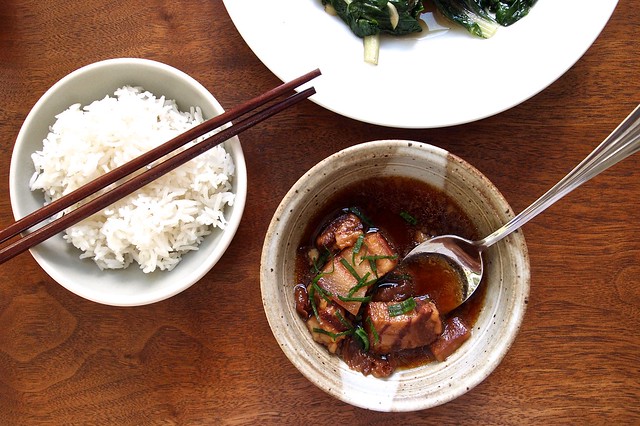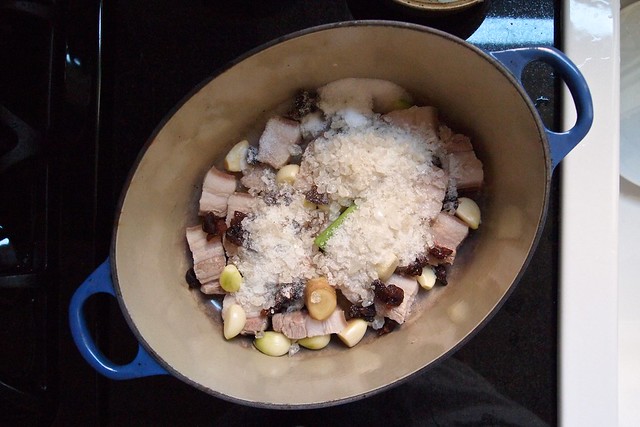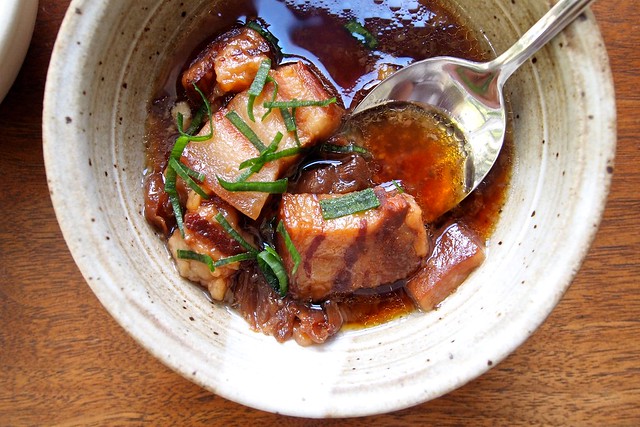Hello, friends. It’s been a while, ages, really. I’ve had my hands full trying to sort some things out. Most of it has had to do with my dissertation. It’s taken me the better part of a year to undo some of the habits and thinking that were holding me back, making me miserable. So, now, writing bits and pieces of it is not quite the terrible thing it once was. And that has opened up my days some. There has been more time for friends and cooking and soaking up the sun. I’ve been in a good place, and I hope that things can stay this way.
Last month, I was in China with my parents for a few weeks. I won’t say much about the sights, though, because, really, this trip for me was about family—the long hours I spent with my mom on the bus, gazing out at the passing scenery (yaks, looming peaks, haphazard fields of tomatoes hugging the winding, narrow mountain roads) and talking quietly, the morning we spent at an open market in Huanlong Valley, threading through the crowds and munching on sweets like the ones my mom grew up with, the last afternoon in Guangzhou when all of us, even my dad, who doesn’t do any of the cooking at home, gathered at the table and fumbled with dumpling wrappers, trying to imitate my uncle’s deft hand movements. It had been years since I’d spent this much uninterrupted time with my parents and almost as long since I’d seen many of these members of my extended family. And though, of course, we got on each other’s nerves occasionally (okay, maybe more), the time we spent together left me feeling closer to them than I have in a while.
I’m not very good at sustaining relationships at a distance. I let the more immediate demands in my life pull me away. And it’s always been especially difficult with my parents, I think. I’ve grown into a person very different from them in a lot of ways. So, there isn’t always a whole lot to talk about from week to week. But having spent so much time with them recently, I’ve been determined not to let things lapse. And as became obvious to me during the trip, the easiest way to do this will be to talk about food.
It’s not as though my mom and I didn’t talk about cooking before this. But up until I started cooking from Fuchsia Dunlop’s books last year, most of what found its way to my table wouldn’t have been anything my mom could’ve related to. During the trip, however, we all talked about food a lot—about the produce we saw at markets, about the cooking methods behind dishes served to us at restaurants, about the greens I was growing back home and what I might plant next year. Cooking more Chinese food—even if it wasn’t exactly the kind of food I’d grown up with—had given me a way of connecting with my family that I hadn’t quite had before.
So, I’ve been trying to do more Chinese cooking since getting back. The dish that’s really stood out since then is another from Fuchsia Dunlop—her red-braised pork with garlic. This dish might be a hard sell for some of you. But I think it’s incredible. You start with a one-pound slab of pork belly. You cut it into one-inch cubes and set these in a heavy pot along with whole garlic cloves, rock sugar, ginger, scallion, Sichuan peppercorns, and dried longan fruit, with water to cover. Then, you cook it all at the barest simmer for ten hours, at the end of which the pork belly pieces are translucent, unctuous, and uncommonly good—a whole-mouth luxury.
Now, the thing that you might hesitate over is the pork belly. There is no way around this: it is mostly fat. To be clear, I’m not usually one to shy away from animal fat. But I tend to think of pork fat as something to cook things in—not as the thing to be eaten. So, even I blanched a little when I unwrapped the parcel from the butcher. There was definitely more fat than muscle on this slab. This dish was seeming like less of a good idea. But I was wrong about that. You want all that fat. The long cook transforms it. It takes on the flavours in the pot and becomes something delicate and meltingly delicious.
Of course, it is still fat. But that’s okay. Red-braised pork is meant to be enjoyed just a morsel or two at a time. Cover the rest of the table with vegetable dishes and gather some friends around. That, anyway, is what I’ll tell my mom when I talk to her about it. (Even if lard was the choice fat for cooking when she was growing up, she has never quite embraced animal fat in the way I have. So, I’m not sure that I’ll be able to talk her into cooking this dish.)
Red-Braised Pork with Garlic
From Fuchsia Dunlop in Lucky Peach no. 11
Note: About the longan fruit. I’m not sure about how widely available these are in North America in their dried form. I coincidentally was given some by a family friend while in China. Dunlop says that you can substitute dates or just go without. About the rock sugar. Rock sugar is a common ingredient that you can find in Chinese grocery stores. It’s less sweet, and possibly less refined, than conventional granulated sugar. It’s sold in large chunks, which you are supposed to break up yourself at home. I’ve found that a mortar and pestle are the best tools for the job. Pound away at it, and it’ll eventually start breaking up.
450 g pork belly with skin
3 heads garlic
1 small piece of ginger (about 25 g), unpeeled
1 scallion
165 g / 3/4 cup sugar, preferably rock sugar
45 g / 1/4 cup dried longan fruit (pits removed)
1 tablespoon sea salt
8 Sichuan peppercorns
Bring a medium pot of water to a boil.
Meanwhile, break up the garlic into cloves and peel them. Use the flat side of a cleaver to crush the ginger and scallion slightly to release their flavours.
Cut the pork into 1-inch chunks. But do not cut it along its vertical axis—it’s okay if the chunks end up longer on this axis. You want each morsel to have a bit of skin and then layers of fat and muscle underneath. (It’s these together that make for the most delicious bites!) Drop the pork into the boiling water and blanch for about a minute. Drain in a colander and then rinse with cold water.
Place the pork and all the remaining ingredients in a heavy-bottomed pot (clay or cast-iron) that will fit them all in a single layer. Add just enough water to cover. Bring the liquid to a boil over medium heat, then cover and cook over extremely low heat for 10 hours, by which time the pork will be fall-apart tender and the garlic will have melted into the sauce.
Before serving, remove and discard the ginger and scallion. Garnish with more fresh scallion if you wish, and serve with plain steamed rice.
Serves 4-6 with other dishes.





Katie, this beautiful post resonated with me in a number of ways (also writing a dissertation, recently traveled back to Iran with my mother, am also terrible at maintaining long-distance communication). All I can say is that I think what you are doing here is a kind of commitment and for that you should feel good. Also: I love Dunlop's cookbooks. I've been doing a lot of cooking from Every Grain of Rice lately. This looks great.
ReplyDelete